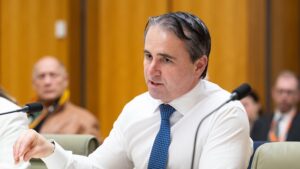
UPDATE: In a bold move, Commonwealth Bank (CBA) CEO Matt Comyn has called for a significant reduction in Australia’s net migration levels to address the escalating housing affordability crisis. During a committee hearing at Parliament House on Tuesday morning, Comyn suggested slashing migration numbers to around 180,000 per year, a staggering 80,000 lower than the government’s forecast of 260,000 this financial year.
Comyn emphasized that a stable migration figure would enable both federal and state governments to better plan for essential infrastructure, particularly housing. “It gives both the Commonwealth and states the ability to plan for critical infrastructure, including housing,” he stated, underscoring the need for coordinated efforts to tackle the housing supply crisis.
Currently, the government projects that net overseas migration will dip to 225,000 by 2026-27. Meanwhile, Coalition Opposition Leader Sussan Ley has already pledged to reduce migration if her party is elected, proposing cuts of more than 100,000 people annually. In contrast, the Labor government has yet to establish a formal migration target.
Comyn warned that while setting ambitious targets may be politically risky, it remains crucial for long-term planning. He also highlighted the urgent need for increased housing supply, stating, “You need a lot of coordination between the federal and the state level.” Additionally, he pointed out challenges in the availability of skilled labor across sectors, including construction.
As the head of Australia’s largest mortgage provider, Comyn noted that growth in housing credit is currently at 6 percent annually, a rate that could raise concerns among policymakers. He indicated that this growth might need to decelerate, particularly given the rising pace among property investors.
Responding to inquiries about the federal government’s recent expansion of the 5 percent deposit scheme, which some critics argue could exacerbate property prices, Comyn downplayed its impact. He remarked that the policy would only contribute a “very, very small element” to the current price increases. The scheme allows first-time homebuyers with a minimum 5 percent deposit to avoid costly lenders mortgage insurance, which can significantly raise the financial barriers to homeownership.
From October 2023, the government will remove income eligibility limits for the scheme and increase the cap on property prices, aiming to enhance accessibility for first-time buyers. However, Treasury estimates suggest this expansion may only raise property prices by about 0.6 percent over the next six years.
With tensions rising over migration and housing affordability, all eyes are on the government and opposition responses in the coming weeks. The urgency of these issues underscores the critical need for a cohesive approach to ensure that all Australians can afford a home in an increasingly competitive market.





